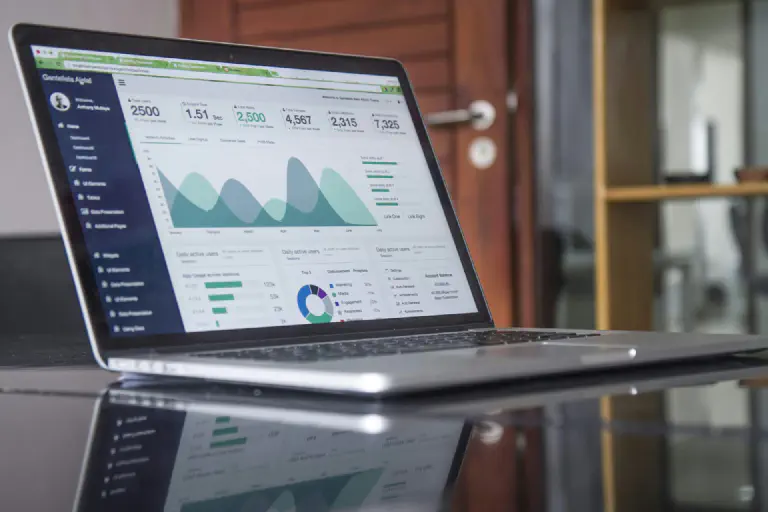Whether you are a young start-up, a medium-sized company or a large corporation: without a clear overview of your own cash flows, things can quickly become risky. Because even if your company is profitable on paper, if you run out of money for wages, rent or materials at short notice, this can threaten your existence. To prevent this, you as a company should calculate your liquidity as a precaution using liquidity planning.
What is liquidity planning? #
Liquidity planning is a central component of financial management and is often decisive in determining whether a company stays on course or runs into trouble. Liquidity planning is about ensuring a company’s solvency. In concrete terms, this means systematically recording, comparing and planning ahead all expected incoming and outgoing payments. This allows you to identify financial bottlenecks at an early stage and initiate countermeasures in good time.
Advantages of liquidity planning #
Careful liquidity planning brings your company many tangible benefits. It ensures improved cash management because it is always clear how much money is actually available to you . You can also track your expenditure more accurately and manage it better, which helps you to make optimum use of your financial leeway.

In addition, good planning enables you to target capital allocation. Instead of leaving money lying around unused or tying it up in the wrong place, you can use it where it will bring the greatest benefit. If you have an overview of your cash flows, you can also plan more strategically – for example, to make investments at the right time or take advantage of favorable market opportunities.
Last but not least, forward-looking liquidity planning often leads to cost savings, for example through better conditions with suppliers or avoiding expensive overdraft interest. At the same time, it helps you to identify financial risks at an early stage and mitigate them before they become a problem.
Liquidity planning methods #
Depending on company size, sector and objectives, there are different approaches to liquidity planning: the direct, indirect and hybrid methods.
With direct liquidity planning, you specifically record all planned cash inflows and outflows within a certain period. This method is very detailed and particularly suitable for short-term planning – for the next few weeks or months, for example. It gives you an exact overview of when money is received and spent. This allows you to recognize bottlenecks at an early stage and react quickly.

Indirect liquidity planning takes a different approach. Here, liquidity is derived from the income statement and planned changes in balance sheet items. This method is less accurate, but is more suitable for medium to long-term planning. Indirect planning provides valuable information, particularly for strategic decisions – such as major investments or borrowing.
In practice, many companies rely on hybrid liquidity planning, which combines both approaches. The direct method is used for short-term management, while the indirect method is used for medium and long-term planning. This gives you a comprehensive view of your solvency and allows you to react flexibly to changes.
How to create a liquidity plan in 7 steps #
A well thought-out liquidity plan is not rocket science – with a clear system, you can keep an eye on your solvency at all times and create an important basis for business decisions. Because if you know exactly when money is coming and going, you can act with foresight instead of reacting in crisis mode. This is how you create a well-founded liquidity plan for your financial plan step by step:
-
Determine planning period: First determine the period for which you want to plan your liquidity. Monthly planning is recommended for starters. For larger companies, weekly or quarterly planning can also be useful – depending on how dynamic your cash flows are.
-
Record the initial balance: Note the current status of your liquid funds – i.e. the amount in your bank accounts and in the cash register. This value is the starting point for your planning.
-
Record deposits: Collect all expected income: Sales, interest, tax refunds, subsidies, possible loan payments or even private deposits. It is important to remain realistic and only count on the money you actually expect to receive.
-
Record disbursements: Record all planned expenses: This includes purchasing costs, salaries, rent, insurance, marketing, taxes, loan repayments and investments. You should also take irregular or seasonal costs into account.
-
Calculate net liquidity: Deduct the payments from the incoming payments. This gives you your net liquidity for the period in question. A positive value means a liquidity surplus – a negative value indicates a possible bottleneck.
-
Calculate closing balance: Add or subtract the net liquidity from the opening balance. This will give you the expected cash balance at the end of the period.
-
Analysis and adjustment: Check your results regularly. Are there critical periods in which your liquidity becomes tight? Do expenses need to be postponed or financing secured? Adjust your planning if necessary, because the more flexibly you can react to changes, the better.
Calculate liquidity ratios #
Liquidity ratios are important key figures for your liquidity plan in order to estimate how quickly a company can settle its short-term liabilities. They show the extent to which liquid funds, receivables or inventories are available to pay outstanding invoices on time. A distinction is made between three liquidity ratios:
1st degree liquidity (cash ratio) #
Liquidity level 1 examines the extent to which a company could cover its short-term liabilities with immediately available means of payment alone – i.e. cash and bank balances.
Formula: Liquidity ratio 1 = (cash and cash equivalents / current liabilities) × 100
A value of 100 % or more means that the company could settle all current liabilities with cash and bank balances alone. In practice, however, this value is often lower because companies do not hold all of their capital on account.
2nd degree liquidity (quick ratio) #
In addition to cash and cash equivalents, short-term receivables – i.e. outstanding payments from customers – are also taken into account here. This provides a more realistic view of short-term solvency.
Formula: Liquidity ratio 2 = (cash and cash equivalents + current receivables) / current liabilities × 100
A value above 100 % is a good sign here, as it shows that cash and cash equivalents and outstanding receivables together are sufficient to cover all current liabilities.
3rd degree liquidity (current ratio) #
With liquidity ratio 3, your entire current assets are included, i.e. not only cash and cash equivalents and receivables but also inventories such as stock.
Formula: Liquidity ratio 3 = (current assets / current liabilities) × 100
This ratio provides a more comprehensive picture. Although inventories cannot be converted into cash immediately, they are part of the assets available in the short term.
Practical calculation example for your liquidity plan #
Imagine your company has the following liquidity reserves:
- € 18,000 cash and cash equivalents (cash, bank)
- € 54,000 current receivables (outstanding customer invoices)
- € 36,000 inventory
- € 60,000 current liabilities (suppliers, loans)
With the so-called liquidity ratios, you can check how well your company is able to settle short-term liabilities – with funds that are quickly available. The calculation is carried out in three stages:
Liquidity level 1 = (€ 18,000 / € 60,000) × 100 = 30%
Liquidity level 2 = (€ 18,000 + € 54,000) / € 60,000 × 100 = 120 %
Liquidity level 3 = (€ 18,000 + € 54,000 + € 36,000) / € 60,000 × 100 = 180 %
What do these values mean? #
A liquidity ratio 1 of 30 % shows you that you can only cover part of your short-term liabilities with cash and bank balances alone. If you include outstanding receivables (liquidity ratio 2), your solvency is already solidly secured at 120 %. Finally, if you also include your inventories (liquidity ratio 3), you achieve an extremely comfortable value of 180 %, which indicates a very stable financial situation.
Why too much liquidity can also be problematic #
At first glance, it sounds ideal if a company has a particularly high level of cash and cash equivalents. After all, this means that all invoices can be paid without any problems and there are no financial bottlenecks in sight. But too much liquidity can also have disadvantages.
Liquid funds that are not used generally bring little or no return . Instead, they even lose value due to inflation. Capital that is sitting in accounts is not working for the company – there is a lack of investments that could secure long-term growth and competitiveness.
In addition, banks or investors can see a permanently high level of liquidity as a sign that the company is not using its capital efficiently. This can worsen the valuation or weaken confidence in the management strategy.

Healthy liquidity planning therefore means finding a smart middle way: enough reserves to remain solvent at all times, but no excessive capital reserves that could be better invested in new projects, innovations or the optimization of processes.
How liquidity planning gets you safely through economic crises #
Particularly in difficult economic times, it becomes clear how crucial solid liquidity planning really is. Companies that suddenly find themselves in a special situation – be it due to market changes, delivery bottlenecks, a decreased order situation or even an overall economic crisis – are often faced with the problem that their income drops drastically while running costs remain constant or even increase.
The worst case scenario is insolvency. If invoices can no longer be paid on time, companies quickly fall into a downward spiral that can lead to insolvency. Forward-looking and consistent liquidity planning is essential for survival in such phases. It helps to regularly plan and monitor cash flows in order to identify bottlenecks at an early stage. If you know when things are getting financially tight, you can initiate measures in good time – for example by adjusting payment terms, securing financing or postponing investments in a targeted manner.

In addition, clear planning allows unnecessary expenditure to be identified and costs to be reduced in a targeted manner. Effective receivables management ensures that outstanding invoices are paid more quickly - a decisive lever for improving liquidity in the short term. It is also advisable to build up a liquidity buffer in order to remain capable of acting in unforeseen situations.
The right software for your liquidity plan #
The Excel alternative SeaTable is a practical tool for liquidity planning. Unlike traditional spreadsheets, SeaTable combines the flexibility of relational databases with familiar spreadsheet functions. This allows you to design your liquidity planning clearly and dynamically. You record incoming and outgoing payments in linked tables, create individual views with just a few clicks (e.g. a Kanban board for open items or a timeline for payment flows) and evaluate your key figures with the help of statistics.
Thanks to integrated formulas, SeaTable automatically calculates your liquidity ratios. Color rules help you to identify outliers or critical periods immediately. You can set up automatic reminders so that you don’t lose sight of payment targets, for example.
Your financial data remains secure: SeaTable meets the highest data protection standards (GDPR-compliant) and allows granular access control. Whether cloud version or on-premises in your data center – you decide where your data is stored.
With its flexible templates and individual workflows, SeaTable adapts precisely to your processes. So you can always keep your liquidity under control with ease.
TAGS: Finances
